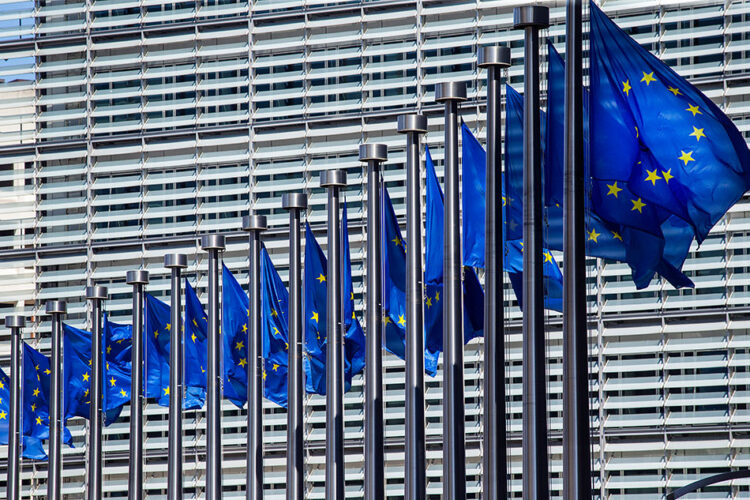Although the European Union is still several years away from implementing its inaugural Digital Product Passport regulations, e-scrap market participants who do business with Europe are preparing for this new phase in sustainability regulations.
The Digital Product Passport, or DPP, is part of the European Commission’s Ecodesign for Sustainable Products Regulation, which took effect July 18, 2024. The ESPR is among numerous measures in the 2020 Circular Economy Action Plan meant to help the EU reach its environmental and climate goals, double its circularity rate of material use and achieve its energy efficiency targets by 2030.
In short, a DPP “is like a barcode, but for data relevant to its sustainability attributes,” said Jon Powell, PhD, founder and CEO of Apex Catalytic, a specialty firm that advises companies and investment funds on sustainability challenges, including with new technology platforms. Powell will moderate a panel discussion on DPPs, “Enhancing Transparency in Electronics Recycling,” on Oct. 2 at the 2024 E-Scrap Conference in Orlando, Florida.
Eventually most products shipped to and within the EU will require a DPP. Batteries will require DPPs starting in 2027.
“As for the projected timeline of digital product passports becoming a reality, we are seeing now that it is very much becoming a reality in Europe,” said David Hirschler, chief sustainability officer at California-based ITAD firm ERI. “We don’t know exactly when it is coming in the U.S. yet, but it is clear that some U.S. players are exploring the concept and technology.”
Hirschler is among the panelists in the conference discussion on DPPs.
“Digital Product Passports go beyond just meeting regulations – they offer enhanced value and transparency throughout the entire supply chain,” said Danny Grande, chief product officer and co-founder at carbon accounting firm Arbor, based in Canada. “These passports enable unprecedented visibility into products, resulting in advantages like better supply chain management, enhanced repair options and heightened trust from all involved parties.
“The EU aims to adopt Digital Product Passports by 2026, with plans for global expansion, including implementation in North America,” Grande added.
An industry in transition
With implementation still nearly three years away, many questions remain, Powell said.
“Right now things are a bit wide open – there are still open questions on fundamentals, like what is the essential sustainability information that should be included in a DPP, and what’s the best technology to actually store information on a product. Thus, many organizations are working to seize an opportunity to gain competitive advantage as details of DPPs firm up,” Powell said.
Nevertheless, “leading companies are getting involved early, particularly to leverage knowledge of their place in the value chain to understand and influence how DPPs will actually be implemented.”
To help address such questions, the European Commission has funded several projects, largely centered on developing pilot programs to help determine the best format for the DPPs.
For example, the four-year BATRAW project, spanning 2022-2026, is focused on developing two pilot systems: one for sustainable recycling and end-of-life management of EV batteries, the other for domestic batteries and battery scraps that contribute to the generation of secondary streams of CRMs and battery raw materials.
Opportunities, challenges ahead
BATRAW also sponsored an in-depth analysis of the new EU regulatory framework via the Centre for European Policy Studies, a think tank based in Brussels, Belgium. The March 2024 report used data collected from companies throughout the battery value chain to identify positive impacts of DPPs.
“The qualitative empirical data suggest that the digital battery passport can help break down information silos among supply chain actors and support recycling and reuse processes,” according to the CEPS analysis. “It also provides opportunities for increasing transparency about carbon footprint impacts across battery supply chains, whilst creating a level playing field with horizontal requirements for all supply chain actors irrespective of their origins.”
However, the report also found several challenges to implementation, such as confidentiality concerns, data silos between entities throughout the battery supply chain, a lack of data standardization, and concerns about the reliability and validity of collected data.
Among the report recommendations were for the Commission to provide more clarity about DPP-related responsibilities at different end-of-life stages and to create a platform to share best practices for battery passport initiatives.
Proliferation of EU-funded projects
BATRAW is just one of several EU-funded projects associated with the rollout of DPP regulations.
Another is Recirculate, which is co-funded by the Swiss government. The project will create a digital marketplace for battery manufacturers, OEMs and recyclers to buy and sell battery components of “known provenance,” to help link the fragmented supply chain for used batteries.
Others include:
- CIRPASS, which consists of 31 consortium partners from academia and industry, aims to develop roadmaps for DPP prototypes. Although the initial CIRPASS project concluded in March, CIRPASS-2 will continue the work by conducting DPP pilots and prototypes in the value chains for batteries, electronics and textiles.
- BatWoMan, based in Austria, applies a battery DPP in the context of production data from pilot factories, to validate the guidelines and standards defined by CIRPASS and Battery Pass. BatWoMan’s ultimate goal is to reduce production costs and energy consumption by more than 50%, according to its website.
- Spain-based BATRAW, a four-year project coordinated by the Technological Centre LEITAT, has 17 partner entities representing seven countries. Its goals include developing and demonstrating a blockchain platform for tracking raw materials, product and supply chain in compliance with DPP regulations.
Other areas ESPR addresses
In addition to DPPs, the ESPR establishes minimum recycled content for EV batteries, starting with lower shares in 2031 and then mostly increasing from 2036:
- Cobalt: 16%; 26%.
- Lead: 85%; 85%.
- Lithium: 6%; 12%.
- Nickel: 6%; 15%.
The regulation also requires that starting in 2025, producers must take back EV batteries free of charge from end users, provide take-back and collection systems and deliver collected waste EV batteries to treatment facilities.
Ahead of the transition, some companies have developed products to help companies remain compliant. For example, Germany-based non-profit IOTA Foundation has partnered with French IT services firm Eviden to create a DPP. The Eviden Digital Passport Solution tracks the life cycle of electronics from the manufacturing stage to recycling, according to a blog post.
What’s next
Batteries are only the first products for DPPs, said Powell.
“The framing for DPPs is in place, but the coming years will establish the specific list of products that will need to have DPPs,” he said. “Because the legislation focuses on products sold in the EU, this means there will be transformational implications for both EU companies and those selling into the EU market, including companies in North America and elsewhere.”
According to the ESPR, future focus areas for the Commission include:
- Chemicals.
- Construction and buildings.
- Electronics and information and communications technology.
- Furniture.
- Plastics.
- Textiles.
Information to be included in the DPP will vary by product, but may include:
- Product’s technical performance.
- Materials and their origins.
- Repair activities.
- Recycling capabilities.
- Life cycle environmental impacts.
The European Commission will start the process by setting priorities, then publish a working plan to specify the products and measures to be addressed under the ESPR, and to provide a time frame. The plan must cover at least three years, according to the legislation.
Then the commission will develop product rules and perform impact assessments, soliciting and incorporating stakeholder feedback in Ecodesign Forums.
“The ESPR is a framework legislation, meaning concrete product rules will be decided progressively over time, on a product-by-product basis, or horizontally, on the basis of groups of products with similar characteristics,” according to the commission’s website.
“Digital Product Passports can only truly function effectively if all participating organizations get on board,” ERI’s Hirschler said. “This is important for U.S. market players, who all need to get involved in order for the system to be uniform.”


























